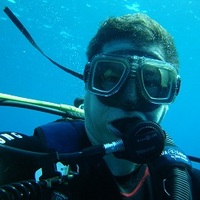
Christopher King
I serve as an archaeologist for the U.S. Navy on Naval Base Guam, Naval Facilities Engineering Command, Marianas (MAVFAC Marianas). I am the installation subject matter expert (SME) in interpreting and applying Federal historic preservation and other cultural resources laws, regulations, standards, and guidelines. Prior to joining NAVFAC Marianas and moving to Guam, I was working as a contract archaeologist for the last few years on the island of Saipan. Additionally, I am an independent remote consultant for WCG IRB as an Institutional Review Board (IRB) member. As an IRB member, I work with a team to review medical research proposals for scientific validity, human subject safety, and federal/state requirements.
I am currently a U.S. Army Reservist (Captain) and serve as a Cultural Heritage and Preservation Officer (Monuments Men) ensuring military cultural heritage protection obligations as outlined in the 1954 Hague Convention for the Protection of Cultural Property in the Event of Armed Conflict.
I received my Bachelor’s Degree in Anthropology and Museum Studies from Baylor University, Master’s Degree in Anthropology (forensic anthropology emphasis) from Florida Atlantic University, and doctorate in Anthropology from the University of Hawaii. In 2007, Dr. King was a post-doctoral fellow as a forensic anthropologist for the Joint POW/MIA Accounting Command, Hawaii.
Address: Guam
I am currently a U.S. Army Reservist (Captain) and serve as a Cultural Heritage and Preservation Officer (Monuments Men) ensuring military cultural heritage protection obligations as outlined in the 1954 Hague Convention for the Protection of Cultural Property in the Event of Armed Conflict.
I received my Bachelor’s Degree in Anthropology and Museum Studies from Baylor University, Master’s Degree in Anthropology (forensic anthropology emphasis) from Florida Atlantic University, and doctorate in Anthropology from the University of Hawaii. In 2007, Dr. King was a post-doctoral fellow as a forensic anthropologist for the Joint POW/MIA Accounting Command, Hawaii.
Address: Guam
less
Related Authors
Noel B. Salazar
KU Leuven
Laurie Reitsema
The University of Georgia
Yulia Antonyan
Yerevan State University
Don Ross
University College Cork
Remo Caponi
University of Cologne
John Tasioulas
University of Oxford
Mary Lewis
University of Reading
Armando Marques-Guedes
UNL - New University of Lisbon
Jonathan Freedman
University of Florida
Scott Fitzpatrick
University of Oregon
InterestsView All (23)










Uploads
Papers by Christopher King
Purpose: The purpose of this investigation was to use an innovative methodology to
generate and validate a curriculum for health professions students from multiple
disciplines.
Method: A multi-phased method using focus groups, surveys, dissemination and affirmation was presented to identify the concepts and best practices that should be included.
Results: Several performance-based themes evolved during the interviews and a
questionnaire was generated. Academic educators, consumers and employers of health care providers indicated agreement that the components on the survey were realistic and important for health professions students to achieve. Thus, outcomes for a curriculum were validated. The faculty rated several components of the curriculum as less realistic for students to achieve than did the consumers and employers. This investigation suggests it may be necessary for faculty to assist providers and parents in developing more realistic expectations about what students can achieve during their educational program. The approach used in this current project moves the field of the health professions curriculum development to a different level when compared with the traditional curriculum development approaches and should be used by others concerned with multi-professional education to assure the validity of the curricula.
(OSSs)—occipital torus tubercles (TOTs), retromastoid processes
(PRs), and posterior supramastoid tubercles (TSPs)—is virtually
restricted to Oceania, with epicenters in the Mariana Islands, Tonga,
Mocha Island, and perhaps other Oceanic locales such as the West
Sepik Coast of New Guinea. Enigmatic in etiology, OSSs are anatomically
related to entheses for the trapezius, superior oblique (suboccipital),
and sternocleidomastoid muscles, respectively. Our study
focuses on Latte Period (950–250 BP) Chamorro ancestors of the
Mariana Islands, contextualized with other skeletal samples from
Remote Oceania, Near Oceania, and the Asian and American
Pacific Rims. Frequent co-variation and pair-wise patterning of multiple
markedly expressed OSSs distinguishes ancestral Chamorros
from all other populations, but markedly expressed individual OSSs
exhibit a broad network of pan-Pacific morphological affinities. The
presence of markedly developed PRs and TSPs in archaic Javanese
hominins indicates deep Southeast Asian origins for these morphs,
but a Northeast Asian origin for tuberculated TOTs is suggested by
their earliest presence in Late Pleistocene Okinawans and Neolithic
Taiwanese. The central goal of this paper is to present and evaluate
evidence that OSSs are informative of both Pacific population history
and the life histories of “bone-forming” Pacific Islander and
Pacific Rim individuals.
"This case illustrates two significant points for anthropologists. First, teaching social science methods from the safety of home is not sufficient to ensure that instruction is not misused; having a daily presence at the site where research is done provides a far more valuable opportunity to instruct. Second, anthropologists or other social scientists may try to sequester our research results to prevent misuse, but if our work is sanitized, what then is its utility? As an anthropologist, I would rather see our discipline engage the world directly rather from the classroom alone, such that our cultural insight may assist decision-makers in working toward informed, positive outcomes."
Temporal variation (sexes combined) in isotopic results show a statistically significant positive shift in δ13Ccollagen, δ15Ncollagen, and δ13Capatite values. Individuals from both the second and first millennium B.C. have varied diets consisting principally of C3 plants, C3 terrestrial animals, and freshwater fish.
During the second millennium B.C., the δ15Ncollagen values suggest consumption of a wider array of protein sources for females than for males. During the first millennium B.C., δ15Ncollagen and δ13Capatite values in females suggest an increase in open field carbohydrate foods and a shift to a greater consumption of either fish and/or carnivorous animals. For males, evidence suggests the consumption of more domesticated animals and less emphasis on wild game.
This dissertation makes a significant contribution to studies of subsistence changes from extensive to intensive agriculture in subtropical monsoon Asia. These stable isotope data substantiate archaeological and paleoenvironmental evidence, and corroborate bioarchaeological information from paleodemography and dental pathological conditions that suggest changes in dietary patterns over time and between the sexes. The use of stable isotopes from human remains from northeast Thailand has provided a direct indication for diet change from pre-state Metal Age societies. This research is relevant to debates of agricultural change as well as the effect of cultural changes on subsistence patterns and the evolution of human diet.
Curricula are developed to educate health professions students to provide efficient and effective health services. In addition to learning their disciplinary perspective, today's students must master the concepts of multidisciplinary team care. Traditionally, curriculum was developed based primarily on the perspectives of the discipline faculty, administration and accrediting agencies. However, now there are multiple groups (other academic educators, consumers and employers of health care providers) who may hold differing perspectives about outcomes expected from these programs.
PURPOSE:
The purpose of this investigation was to use an innovative methodology to generate and validate a curriculum for health professions students from multiple disciplines.
METHOD:
A multi-phased method using focus groups, surveys, dissemination and affirmation was presented to identify the concepts and best practices that should be included.
RESULTS:
Several performance-based themes evolved during the interviews and a questionnaire was generated. Academic educators, consumers and employers of health care providers indicated agreement that the components on the survey were realistic and important for health professions students to achieve. Thus, outcomes for a curriculum were validated. The faculty rated several components of the curriculum as less realistic for students to achieve than did the consumers and employers. This investigation suggests it may be necessary for faculty to assist providers and parents in developing more realistic expectations about what students can achieve during their educational program. The approach used in this current project moves the field of the health professions curriculum development to a different level when compared with the traditional curriculum development approaches and should be used by others concerned with multi-professional education to assure the validity of the curricula.
Purpose: The purpose of this investigation was to use an innovative methodology to
generate and validate a curriculum for health professions students from multiple
disciplines.
Method: A multi-phased method using focus groups, surveys, dissemination and affirmation was presented to identify the concepts and best practices that should be included.
Results: Several performance-based themes evolved during the interviews and a
questionnaire was generated. Academic educators, consumers and employers of health care providers indicated agreement that the components on the survey were realistic and important for health professions students to achieve. Thus, outcomes for a curriculum were validated. The faculty rated several components of the curriculum as less realistic for students to achieve than did the consumers and employers. This investigation suggests it may be necessary for faculty to assist providers and parents in developing more realistic expectations about what students can achieve during their educational program. The approach used in this current project moves the field of the health professions curriculum development to a different level when compared with the traditional curriculum development approaches and should be used by others concerned with multi-professional education to assure the validity of the curricula.
(OSSs)—occipital torus tubercles (TOTs), retromastoid processes
(PRs), and posterior supramastoid tubercles (TSPs)—is virtually
restricted to Oceania, with epicenters in the Mariana Islands, Tonga,
Mocha Island, and perhaps other Oceanic locales such as the West
Sepik Coast of New Guinea. Enigmatic in etiology, OSSs are anatomically
related to entheses for the trapezius, superior oblique (suboccipital),
and sternocleidomastoid muscles, respectively. Our study
focuses on Latte Period (950–250 BP) Chamorro ancestors of the
Mariana Islands, contextualized with other skeletal samples from
Remote Oceania, Near Oceania, and the Asian and American
Pacific Rims. Frequent co-variation and pair-wise patterning of multiple
markedly expressed OSSs distinguishes ancestral Chamorros
from all other populations, but markedly expressed individual OSSs
exhibit a broad network of pan-Pacific morphological affinities. The
presence of markedly developed PRs and TSPs in archaic Javanese
hominins indicates deep Southeast Asian origins for these morphs,
but a Northeast Asian origin for tuberculated TOTs is suggested by
their earliest presence in Late Pleistocene Okinawans and Neolithic
Taiwanese. The central goal of this paper is to present and evaluate
evidence that OSSs are informative of both Pacific population history
and the life histories of “bone-forming” Pacific Islander and
Pacific Rim individuals.
"This case illustrates two significant points for anthropologists. First, teaching social science methods from the safety of home is not sufficient to ensure that instruction is not misused; having a daily presence at the site where research is done provides a far more valuable opportunity to instruct. Second, anthropologists or other social scientists may try to sequester our research results to prevent misuse, but if our work is sanitized, what then is its utility? As an anthropologist, I would rather see our discipline engage the world directly rather from the classroom alone, such that our cultural insight may assist decision-makers in working toward informed, positive outcomes."
Temporal variation (sexes combined) in isotopic results show a statistically significant positive shift in δ13Ccollagen, δ15Ncollagen, and δ13Capatite values. Individuals from both the second and first millennium B.C. have varied diets consisting principally of C3 plants, C3 terrestrial animals, and freshwater fish.
During the second millennium B.C., the δ15Ncollagen values suggest consumption of a wider array of protein sources for females than for males. During the first millennium B.C., δ15Ncollagen and δ13Capatite values in females suggest an increase in open field carbohydrate foods and a shift to a greater consumption of either fish and/or carnivorous animals. For males, evidence suggests the consumption of more domesticated animals and less emphasis on wild game.
This dissertation makes a significant contribution to studies of subsistence changes from extensive to intensive agriculture in subtropical monsoon Asia. These stable isotope data substantiate archaeological and paleoenvironmental evidence, and corroborate bioarchaeological information from paleodemography and dental pathological conditions that suggest changes in dietary patterns over time and between the sexes. The use of stable isotopes from human remains from northeast Thailand has provided a direct indication for diet change from pre-state Metal Age societies. This research is relevant to debates of agricultural change as well as the effect of cultural changes on subsistence patterns and the evolution of human diet.
Curricula are developed to educate health professions students to provide efficient and effective health services. In addition to learning their disciplinary perspective, today's students must master the concepts of multidisciplinary team care. Traditionally, curriculum was developed based primarily on the perspectives of the discipline faculty, administration and accrediting agencies. However, now there are multiple groups (other academic educators, consumers and employers of health care providers) who may hold differing perspectives about outcomes expected from these programs.
PURPOSE:
The purpose of this investigation was to use an innovative methodology to generate and validate a curriculum for health professions students from multiple disciplines.
METHOD:
A multi-phased method using focus groups, surveys, dissemination and affirmation was presented to identify the concepts and best practices that should be included.
RESULTS:
Several performance-based themes evolved during the interviews and a questionnaire was generated. Academic educators, consumers and employers of health care providers indicated agreement that the components on the survey were realistic and important for health professions students to achieve. Thus, outcomes for a curriculum were validated. The faculty rated several components of the curriculum as less realistic for students to achieve than did the consumers and employers. This investigation suggests it may be necessary for faculty to assist providers and parents in developing more realistic expectations about what students can achieve during their educational program. The approach used in this current project moves the field of the health professions curriculum development to a different level when compared with the traditional curriculum development approaches and should be used by others concerned with multi-professional education to assure the validity of the curricula.